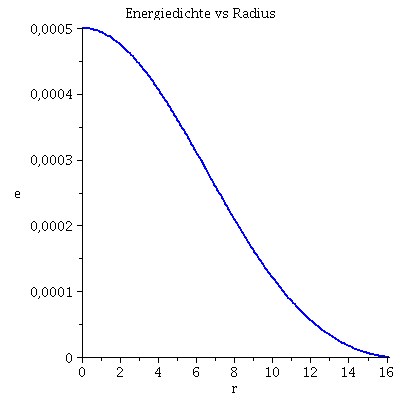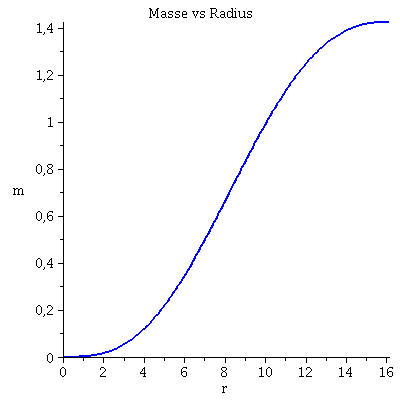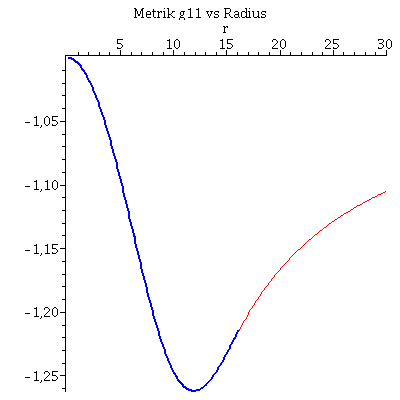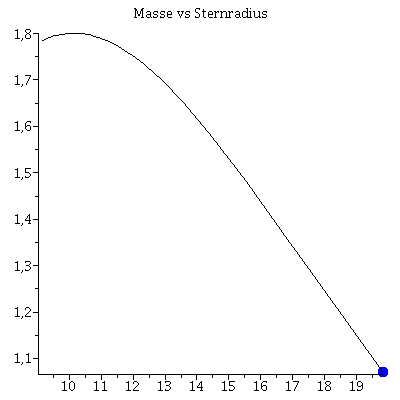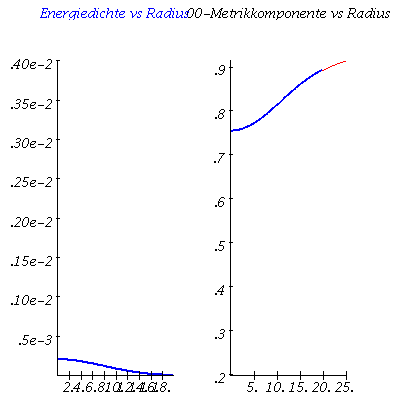Download Maple Worksheed
Allgemeine Relativitätstheorie mit dem Computer
General Theory of Relativity on the Computer
Vorlesung gehalten an der J.W.Goethe-Universität in Frankfurt am Main (Sommersemester 2016)
von Dr.phil.nat. Dr.rer.pol. Matthias Hanauske
Frankfurt am Main 11.04.2016
Erster Vorlesungsteil: Allgemeine Relativitätstheorie mit Maple
4. Vorlesung
Einführung
In den folgenden drei Vorlesungen wurde die Geodätengleichung in vorgegebener Schwarzschild Raumzeit für unterschiedliche Anfangsbedingungen numerisch analysiert. Die raumzeitliche Struktur, die Metrik, wurde hierbei als gegeben vorausgesetzt. In der folgenden Vorlesung betrachteten wir nun wie man die Metrik bei vorgegebener Materieverteilung berechnet. Die zugrundeliegende Gleichung die es hier zu lösen gilt ist die Einstein Gleichung.
Die innere Schwarzschildlösung eines sphärisch symetrischen, statischen Objektes (z.B. Erde, Neutronenstern)
Im folgenden wird die Einsteingleichung einer sphärisch symetrischen und statischen Matrieverteilung betrachtet. Die Matrie wird hierbei als ideale Flüssigkeit angesetzt.
Von der Einstein Gleichung zur Tollman-Oppenheimer-Vollkov Gleichung (TOV)
| > | restart:
with( tensor ): |
Sphärisch symetrischer und statischer Ansatz der Metrik:
| > | coord := [t, r, theta, phi]:
g_compts := array(symmetric,sparse, 1..4, 1..4): g_compts[1,1] := exp(2*phi(r)): #g_compts[2,2] := exp(2*lambda(r)): g_compts[2,2] := -1/(1-2*m(r)/r): g_compts[3,3] := -r^2: g_compts[4,4] := -r^2*sin(theta)^2: g := create( [-1,-1], eval(g_compts)); |
  |
(2.1.1) |
| > | ginv := invert( g, 'detg' );
D1g := d1metric ( g, coord ): D2g := d2metric ( D1g, coord ): Cf1 := Christoffel1 ( D1g ): Cf2 := Christoffel2(ginv, Cf1): |
  |
(2.1.2) |
| > | RMN := Riemann( ginv, D2g, Cf1 ):
RMNinv:= raise(ginv,RMN,1,2,3,4): RMNc:=get_compts(RMN): RICCI := Ricci( ginv, RMN ): RS := Ricciscalar( ginv, RICCI ): |
Kovariante Form des Einsteintensors:
| > | G := Einstein( g, RICCI, RS ); |
  |
(2.1.3) |
Der Energie-Impuls Tensor (rechte Seite der Einsteingleichung) wird als ideale Flüssigkeit angesetzt:
| > | T:=create([1,-1], array([[e(r),0,0,0],[0,-p(r),0,0],[0,0,-p(r),0],[0,0,0,-p(r)]]));
Tl:=lower(g,T,1); Tu:=raise(ginv,T,2): prod(ginv, Tl, [2, 1]): contract(T, [1, 2]): |
 |
|
  |
(2.1.4) |
Nichtverschwindende Komponenten der Einsteingleichung:
| > | Einsteingl:=lin_com(G,8*Pi,Tl);
|
  |
(2.1.5) |
| > | A:=get_compts(Einsteingl): |
Erste Gleichung der Einsteingleichung (tt-Komponente) wird nach dm/dr aufgelößt.
Zweite Gleichung der Einsteingleichung (rr-Komponente) wird nach dphi/dr aufgelößt.
| > | Einstein1:=diff(m(r), r)=solve(A[1,1],diff(m(r), r));
Einstein2:=diff(phi(r),r)=solve(A[2,2],diff(phi(r),r)); |
| (2.1.6) |
Mittels der hydrodynamischen Gleichungen (kovariante Erhaltung des Energie-Impulses) erhalten wir
| > | DT:=cov_diff(T, coord, Cf2):
DTa:=get_compts(contract(DT, [1, 3]))[2]=0; |
| (2.1.7) |
.was nach dp/dr aufgelößt das folgende ergibt:
| > | diff(p(r), r)=collect(solve(DTa,diff(p(r), r)),diff(phi(r), r)); |
| (2.1.8) |
Die TOV-Gleichung erhalten wir, indem man diese Gleichung nach dphi/dr auflößt und das Ergebnis in die zweite Gleichung der Einsteingleichung einsetzt:
| > | solve(DTa,diff(phi(r), r))*(e(r)+p(r))*(-1)=rhs(Einstein2)*(e(r)+p(r))*(-1); |
| (2.1.9) |
| > | TOV1:=solve(DTa,diff(phi(r), r))*(e(r)+p(r))*(-1)=rhs(Einstein2)*(e(r)+p(r))*(-1);
TOV2:=Einstein1; TOV3:=Einstein2; |
| (2.1.10) |
Numerische Lösung der TOV-Gleichungen
Im folgenden werden die TOV-Gleichungen numerisch gelößt, indem wir einerseits eine Zustandsgleichung der Materie (eine Funktion p(e)) festlegen und von einem Startwert der zentralen Energiedichte im Inneren des sphärisch symetrischen Objektes nach Außen integrieren.
| > | a:=10;
b:=5/3: p(r):=a*(e(r))^b; W3:=plot(a*x^b,x=0..1,color=blue): TOV1:=solve(DTa,diff(phi(r), r))*(e(r)+p(r))*(-1)=rhs(Einstein2)*(e(r)+p(r))*(-1); TOV2:=Einstein1; TOV3:=Einstein2; |
| (2.2.1) |
Numerische Lösung der Gleichung mitfixierten Randbedingungen im Sternzentrum.
| > | r0:=10^(-14):
e0:=0.0005; Loes:=dsolve({TOV1,TOV2,m(r0)=0,e(r0)=e0},{m(r),e(r)},type=numeric,output=listprocedure); |
| (2.2.2) |
Numerische Lösung vom Sternzentrum aus integriert:
| > | with(plots):
rend:=16.12487: Plot1:=odeplot(Loes,[r,e(r)],r0..rend,numpoints=200,color=blue,thickness=2,title="Energiedichte vs Radius"): Plot2:=odeplot(Loes,[r,m(r)],r0..rend,numpoints=200,color=blue,thickness=2,title="Masse vs Radius"): display(Matrix(1,2,[Plot1,Plot2])); |
|
Aufgrund des Birkov Theorems muss die Innenlösung der Metrik in die äussere Schwarzschildmetrik am Sternrand übergehen. Da wir nun die Gesamtmasse des Sterns kennen, können wir auch die innere g00 und g11 Komponente der Metrik angeben: Integration nun von der Sternoberfläche nach Innen:
| > | Mass := subs(Loes,m(r)):
M:=Mass(rend); Phi0:=(0.5*ln(1-2*Mass(rend)/rend)): Loes1:=dsolve({TOV1,TOV2,TOV3,m(rend)=Mass(rend),e(rend)=10^(-25),phi(rend)=Phi0},{m(r),e(r),phi(r)},type=numeric,output=listprocedure); |
| (2.2.3) |
Veranschaulichung der g00-Komponente (linke Abbildung) und g11-Komponente (rechte Abbildung) der Innenraummetrik (blaue Kurven) und Außenraummetrik (rote Kurven).
| > | ranf:=10^(-1):
Plot3:=odeplot(Loes1,[r,exp(2*phi(r))],ranf..rend,numpoints=200,color=blue,thickness=2,title="Metrik g00 vs Radius"): Plot4:=odeplot(Loes1,[r,-1/(1-2*m(r)/r)],ranf..rend,numpoints=200,color=blue,thickness=2,title="Metrik g11 vs Radius"): Plot5:=plot(1-2*M/r,r=rend..30,color=red): Plot6:=plot(-1/(1-2*M/r),r=rend..30,color=red): display(Matrix(1,2,[[display(Plot3,Plot5),display(Plot4,Plot6)]])); |
|
| > |
Masse-Radius Beziehung
Im folgenden wird eine Sequenz von Sternen mit unterschiedlichen zentralen Energiedichten-Werten berechnet. Trägt man die Gesamtmasse der einzelnen Sterne gegen deren Radius auf, so erhält man die Masse-Radius Beziehung und erkennt die, der benutzten Zustandsgleichung eigenen, maximale Masse. Die Berechnung erfolgt durch eine for-Schleife über einen geeigneten zentralen Energiedichtebereich:
| > | r0:=10^(-14):
ranf:=10^(-1): frames:=20: for i from 1 by 1 to frames do e0:=i*0.0002: Loes:=dsolve({TOV1,TOV2,TOV3,m(r0)=0,e(r0)=e0,phi(r0)=0},{m(r),e(r),phi(r)},type=numeric,output=listprocedure): energiedichte := subs(Loes,e(r)): Mass := subs(Loes,m(r)): PPhi := subs(Loes,phi(r)): for rr from 1 by 0.0001 while energiedichte(rr)>10^(-10) do Radius[i]:=rr: end do: Masse[i]:=Mass(Radius[i]); Plot1[i]:=odeplot(Loes,[r,e(r)],r0..Radius[i],numpoints=200,color=blue,thickness=2,title="Energiedichte vs Radius",view=[r0..20,0..0.004]): Phi0:=(0.5*ln(1-2*Masse[i]/Radius[i])): DPhi:=Phi0-PPhi(Radius[i]): Plot3[i]:=odeplot(Loes,[r,exp(2*(phi(r)+DPhi))],r0..Radius[i],numpoints=200,color=blue,thickness=2,labels=[Radius,"00-Metrikkomponente"],labeldirections=[horizontal, vertical],title="00-Metrikkomponente vs Radius"): Plot5[i]:=plot(1-2*Masse[i]/r,r=Radius[i]..25,color=red): Ani1[i]:=display(Matrix(1,2,[[Plot1[i],display(Plot3[i],Plot5[i])]])); PointA[i]:=pointplot({[Radius[i], Masse[i]]}, symbol=solidcircle,symbolsize=23,color=blue): od: |
| > | MR:=listplot([seq([Radius[i], Masse[i]], i = 1 .. frames)],title="Masse vs Sternradius"):
for i from 1 by 1 to frames do Ani2[i]:=display(PointA[i],MR); od: |
| > | Animat:=display([seq(Ani1[i],i=1..frames)],insequence=true):
Animat1:=display([seq(Ani2[i],i=1..frames)],insequence=true): display(Array([Animat1,Animat])); |
|
| > |
Weiße Zwerge, Neutronensterne und Quarksterne
Die zugrundeliegende Zustandsgleichung der Materie (die Funktion p(e)) zusammen mit dem Startwert der zentralen Energiedichte im Inneren des Sterns legen die Eigenschaften des Sterns fest. Weiße Zwerge haben eine viel geringere zentrale Energiedichte und ihre Zustandsgleichung wird durch den Elektronendruck verursacht. Bei Neutronen und Quarksternen ist die Zustandsgleichung maßgeblich durch den Druck der Neutronen bzw. der Quarks bestimmt. Im Teil 2 dieser Vorlesung werden wir die Eigenschaften dieser unterschiedlicher Sterne im Detail betrachten.
Literatur:
Sagert, Irina, Matthias Hempel, and Carsten Greiner. "Compact stars for undergraduates." European journal of physics 27.3 (2006): 577.
Silbar, Richard R., and Sanjay Reddy. "Neutron stars for undergraduates." American journal of physics 72.7 (2004): 892-905.
David Blaschke, "Structure of White Dwarfs and Neutron Stars" (siehe www.ift.uni.wroc.pl-blaschke-vorles-CS_2.pdf)
| > |
